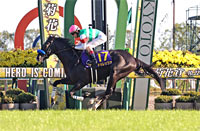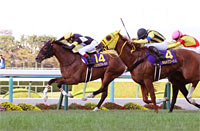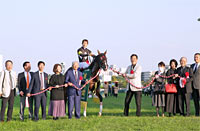Kikuka Sho (Japanese St. Leger) (G1) - Data Analysis
Stamina is key in final leg of Triple Crown
With the spring Satsuki Sho (Japanese 2000 Guineas) and the summer Tokyo Yushun (Japanese Derby) behind us, all eyes are now on the final leg of the classic Triple Crown. A turf 3,000m distance is likely to be a first experience for the 3-year-old runners, and in the past, we have witnessed dramatic finishes with the horses and jockeys demonstrating great perseverance and tactics. Let’s now analyze some features shared by successful runners in this race from results over the last 10 years.
Prepare for a strong showing by unfavored runners
Looking at performances by runners over the last 10 years in terms of favoritism, we observe that “race favorites” achieved a Top 3 ratio of 80.0%. Meanwhile, runners backed as “2nd-5th favorite” struggled with slightly weak success ratios, while runners backed as “6th–9th favorite” produced nine Top 3 finishers and achieved a Top 3 ratio comparable to those backed as “2nd–5th favorite.” [Table 1]
[Table 1] Performance by favoritism (last 10 years)
| Favoritism |
Performance
[1st-2nd-3rd-4th or lower] |
Win ratio |
Top 2 ratio |
Top 3 ratio |
| 1st favorite |
6-1-1-2 |
60.0% |
70.0% |
80.0% |
| 2nd favorite |
0-2-0-8 |
0% |
20.0% |
20.0% |
| 3rd favorite |
1-0-2-7 |
10.0% |
10.0% |
30.0% |
| 4th favorite |
0-1-0-9 |
0% |
10.0% |
10.0% |
| 5th favorite |
1-2-0-7 |
10.0% |
30.0% |
30.0% |
| 6th-9th favorite |
2-2-5-31 |
5.0% |
10.0% |
22.5% |
| 10th favorite or lower |
0-2-2-86 |
0% |
2.2% |
4.4% |
Watch for runners coming from the Kobe Shimbun Hai (Japanese St. Leger Trial)
Looking at performances by runners over the last 10 years in terms of their previous race, we find that 19 Top 3 finishers contested the Kobe Shimbun Hai (Japanese St. Leger Trial) as their previous race, and that this group also delivered the highest success ratios. At the same time, runners that contested the Asahi Hai St. Lite Kinen (Japanese St. Leger Trial) as their previous race only delivered a Top 3 ratio of 10.0%, below the 13.2% achieved by runners who appeared here from a 3-win class turf race. [Table 2]
[Table 2] Performance by previous race (last 10 years)
| Previous race |
Performance
[1st-2nd-3rd-4th or lower] |
Win ratio |
Top 2 ratio |
Top 3 ratio |
Kobe Shimbun Hai
(Japanese St. Leger Trial) |
8-6-5-51 |
11.4% |
20.0% |
27.1% |
Asahi Hai St. Lite Kinen
(Japanese St. Leger Trial) |
1-3-1-45 |
2.0% |
8.0% |
10.0% |
| 3-win class turf race |
1-0-4-33 |
2.6% |
2.6% |
13.2% |
| Sapporo Kinen |
0-1-0-1 |
0% |
50.0% |
50.0% |
| Other race |
0-0-0-20 |
0% |
0% |
0% |
Watch distance of recent races with a Top 3 finish
Looking at performances by runners over the last 10 years in terms of the longest distance for which a Top 3 finish was achieved in their two previous races, we observe that runners that finished in the Top 3 of a “2,400m” race (such as the Tokyo Yushun (Japanese Derby) or the Kobe Shimbun Hai (Japanese St. Leger Trial)) achieved the highest Top 3 ratio, at 41.5%. This group was followed by runners that finished in the Top 3 of a “2,200m” race (such as the Asahi Hai St. Lite Kinen (Japanese St. Leger Trial)). Runners that finished in the Top 3 of a “2,500m+” race produced zero winners and runners-up, but two third-place finishers (Yuki Soldier in 2012 and Gold Actor in 2014), both of which were backed as 7th favorites. This suggests we should be prepared for strong performances by runners that have achieved success in long-distance races regardless of their favoritism. [Table 3]
[Table 3] Performance by longest distance for which a Top 3 finish was achieved in two previous races (last 10 years)
| Longest distance |
Performance
[1st-2nd-3rd-4th or lower] |
Win ratio |
Top 2 ratio |
Top 3 ratio |
| 1,700m |
0-0-0-1 |
0% |
0% |
0% |
| 1,800m |
1-0-0-18 |
5.3% |
5.3% |
5.3% |
| 2,000m |
0-1-1-22 |
0% |
4.2% |
8.3% |
| 2,200m |
1-2-2-25 |
3.3% |
10.0% |
16.7% |
| 2,400m |
8-5-4-24 |
19.5% |
31.7% |
41.5% |
| 2,500m or higher |
0-0-2-13 |
0% |
0% |
13.3% |
No such distance covered
in two previous races |
0-2-1-47 |
0% |
4.0% |
6.0% |
Runners with most Top 3 finishes in previous three races are strong performers
Looking at performances by runners over the last 10 years in terms of the number of Top 3 finishes achieved in the previous three races, we find that 18 of the 20 Top 2 finishers (including 10 winners) finished in the Top 3 at least twice in the previous three races. Runners with “three” or “two” Top 3 finishes in their three previous races achieved substantially higher success ratios than their counterparts with “one” or “zero” such finishes. Accordingly, it seems we should place a premium on runners that have finished in the Top 3 several times in the previous three races. [Table 4]
[Table 4] Performance by number of Top 3 finishes in previous three races (last 10 years)
Number of
Top 3 finishes |
Performance
[1st-2nd-3rd-4th or lower] |
Win ratio |
Top 2 ratio |
Top 3 ratio |
| Three times |
7-1-1-29 |
18.4% |
21.1% |
23.7% |
| Two times |
3-7-4-43 |
5.3% |
17.5% |
24.6% |
| One time |
0-0-4-59 |
0% |
0% |
6.3% |
| Zero times |
0-2-1-19 |
0% |
9.1% |
13.6% |
Seek out the winner!
Watch for finish in the Satsuki Sho (Japanese 2000 Guineas)
Looking at performances by the last 10 winners in the spring of the same year, we observe that five of the 10 winners had run in the Satsuki Sho (Japanese 2000 Guineas) and also finished in the Top 3. In addition, for the remaining five winners (who did not run in the Satsuki Sho), if we look at their class at the end of April, we note that they were all in either the maiden or allowance classes: three maidens (of which one yet to make his debut) and two in the 1-win class. In other words, we would do well not to overlook allowance-class runners or those who had yet to make their first run at the time of the Satsuki Sho in the spring. [Table 5]
[Table 5] List of winners by performance in the Satsuki Sho and, for those not entered in the Satsuki Sho, their class as of April of the same year (last 10 years)
| Year |
Winner |
Finish in Satsuki Sho |
Class |
| 2008 |
Oken Bruce Lee |
Not entered |
Maiden |
| 2009 |
Three Rolls |
Not entered |
1-win class |
| 2010 |
Big Week |
Not entered |
Maiden |
| 2011 |
Orfevre |
1st |
‐ |
| 2012 |
Gold Ship |
1st |
‐ |
| 2013 |
Epiphaneia |
2nd |
‐ |
| 2014 |
Toho Jackal |
Not entered |
Maiden (no previous race) |
| 2015 |
Kitasan Black |
3rd |
‐ |
| 2016 |
Satono Diamond |
3rd |
‐ |
| 2017 |
Kiseki |
Not entered |
1-win class |
(Michio Kawano)
|



















